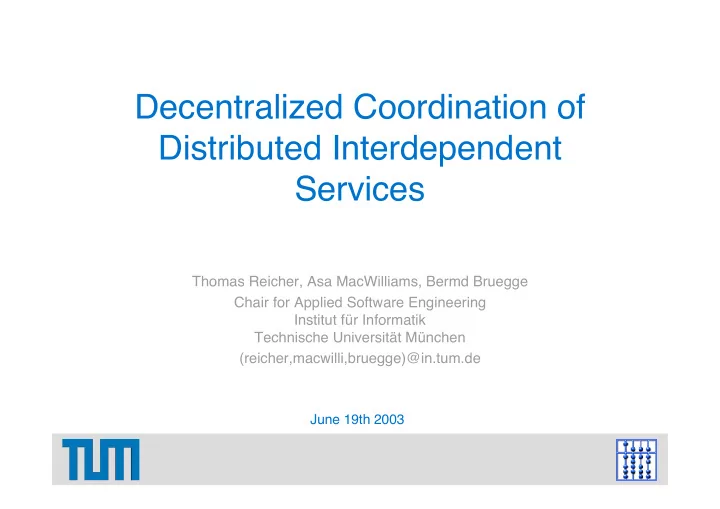

Decentralized Coordination of Distributed Interdependent Services Thomas Reicher, Asa MacWilliams, Bermd Bruegge Chair for Applied Software Engineering Institut für Informatik Technische Universität München (reicher,macwilli,bruegge)@in.tum.de June 19th 2003
The DWARF Framework • Mobile AR in ubiquitous computing environments • Already built AR supported scenarios: – Navigation (Pathfinder) – Maintenance (TRAMP) – Multi-Player Game (SHEEP) – Collaborative Building Design (ARCHIE) Middleware 2002 WiP Asa MacWilliams, Thomas Reicher, Bernd Bruegge June 19th 2003 2
Problems • Goal: Seamless integration of local and remote components – DWARF uses a distributed approach – No separation between local and remote component on architectural layer • Components offer own services and need other services – > service interdependency – Applications are not simply star-shaped but build a service graph of interdependent services • Services are distributed on several deployment units – > no centralized coordination and configuration possible • Usually 10 to 50 services per application Middleware 2002 WiP Asa MacWilliams, Thomas Reicher, Bernd Bruegge June 19th 2003 3
Example • A View component needs position and orientation data • A Tracker can provide orientation data in a particular format • A Filter component must translate between Tracker and View • The Tracker needs feature information for image processing View Filter Tracker MarkerInfo Middleware 2002 WiP Asa MacWilliams, Thomas Reicher, Bernd Bruegge June 19th 2003 4
Approach • Service model for interdependent services – Service have Attributes and Predicates. – They can be variables which are set at runtime. • Runtime Infrastructure establishes connection between service automatically (management, lookup, connection) Service * * Need Connector Ability * * * * Predicate Attribute Middleware 2002 WiP Asa MacWilliams, Thomas Reicher, Bernd Bruegge June 19th 2003 5
Example Service: Optical Tracker <service name="OpticalTracker"> <attribute name="Room" value="Studio"/> <attribute name="Lag" value="0.01"/> <attribute name="Accuracy" value="0.001"/> <need name="markerData" type="MarkerData" predicate="(&(Thing=*)(User=*))"> <connector protocol="ObjrefImport"/> </need> <need name="videoStream" type="VideoStream"> <connector protocol="RTSPReceive"/> </need> <ability name="poseData" type="PoseData" isTemplate="true"> <attribute name="Thing" value="$(markerData.Thing)"> <attribute name="User" value="$(markerData.User)"> <connector protocol="NotificationPush"/> </ability> </service> Middleware 2002 WiP Asa MacWilliams, Thomas Reicher, Bernd Bruegge June 19th 2003 6
Service Chains • Service instantiation – Singleton Services exist only once – Template Services have multiple instances and can be started on demand by the runtime environment • Formation of chains of services – Services are connected automatically based on context and service-specific attributes – Attribute values are handed over from Abilities to Needs • Services for configuration – Service are configured through Configuration Services – Selection of the correct one over context attributes – Selector Service for user defined connection Middleware 2002 WiP Asa MacWilliams, Thomas Reicher, Bernd Bruegge June 19th 2003 7
Setup of a Service Chain Middleware 2002 WiP Asa MacWilliams, Thomas Reicher, Bernd Bruegge June 19th 2003 8
Conclusion • Service model used for several AR applications • Configuration Service and Selector Service are being tested • Hops of Attribute values from Abilities to Needs work. Particularly needed for selection of correct Configuration Service instance • There are use cases for the opposite way, from Need to Ability • Simulations and tests needed to find best set of context attributes for clear service selection Middleware 2002 WiP Asa MacWilliams, Thomas Reicher, Bernd Bruegge June 19th 2003 9
Recommend
More recommend